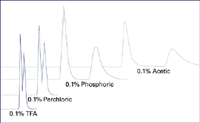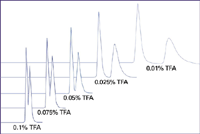Effects of Various Acids and Acid Concentration on a ChiroSil® Crown-Ether Chiral Stationary Phase
The Chirosil RCA(+) and SCA(–) chiral stationary phases (CSPs) are specialized chiral phases very effective in separating various natural and unnatural amino acids as well as compounds containing primary amines.
Ted Szczerba, Regis Technologies, Inc.
The Chirosil® RCA(+) and SCA(–) chiral stationary phases (CSPs) are specialized chiral phases very effective in separating various natural and unnatural amino acids as well as compounds containing primary amines. They are also successfully used for chiral resolution of chiral amino alcohols including therapeutically active compounds such as amphetamine, phenylethanolamine, octopamine, and norepinephrine. The Chirosil® RCA(+) and SCA(–) are covalently bonded, show high performance and durability, and have the ability to invert elution order.

Figure 1: Chromatogram Set #1: Column: 15 cm à 4.6 mm Chirosil® SCA(â). Mobile Phase: Methanol/Water (70/30) + acid. Flow Rate: 1.0 mL/min.The experimental analysis was performed on the (D,L)-DOPA in order to study the effects of various acids and acid concentration in the method development process.
An Agilent 1200 HPLC system was used for the study. Chromatography was performed on a Chirosil® SCA(–) chiral column, 15 cm × 4.6 mm. The effect of acidic modifiers in the mobile phase was studied using four acids: trifluoroacetic acid (TFA), perchloric acid, phosphoric acid, and acetic acid. The aim of the study is to demonstrate the scope of method development options and propose a simple way to optimize separation methods.
Table I summarizes the effect of different acids. Chromatogram Set #1 (Figure 1) illustrates the chromatograms.

Table I: Summary of the effect of different acids
Table II summarizes the effect of acid concentration. Chromatogram Set #2 (Figure 2) illustrates the chromatograms.

Table II: Summary of the effect of acid concentration

Figure 2: Chromatogram Set #2: Column: 15 cm à 4.6 mm Chirosil® SCA(â). Mobile Phase: Methanol/Water (70/30) + acid. Flow Rate: 1.0 mL/min.
Conclusions
Different acids and acid concentrations play a key role in the method development process on a Chirosil® Crown Ether column. The behavior of each acid is sample dependant. All four acids should be tried to achieve the best separation and resolution of your test analyte. The separation can be further optimized by adjusting the acid concentration. Other parameters that should be explored are organic modifier choices (ethanol, methanol, acetonitrile, etc.) in the mobile phase and column temperature.
Regis Technologies, Inc.

8210 Austin Ave., Morton Grove, IL 60053
tel. (847) 583-7661; fax (847) 967-1214
Email: teds@registech.com; Website: www.registech.com/chiral/

SEC-MALS of Antibody Therapeutics—A Robust Method for In-Depth Sample Characterization
June 1st 2022Monoclonal antibodies (mAbs) are effective therapeutics for cancers, auto-immune diseases, viral infections, and other diseases. Recent developments in antibody therapeutics aim to add more specific binding regions (bi- and multi-specificity) to increase their effectiveness and/or to downsize the molecule to the specific binding regions (for example, scFv or Fab fragment) to achieve better penetration of the tissue. As the molecule gets more complex, the possible high and low molecular weight (H/LMW) impurities become more complex, too. In order to accurately analyze the various species, more advanced detection than ultraviolet (UV) is required to characterize a mAb sample.















